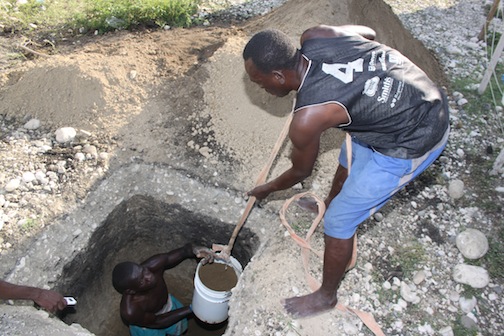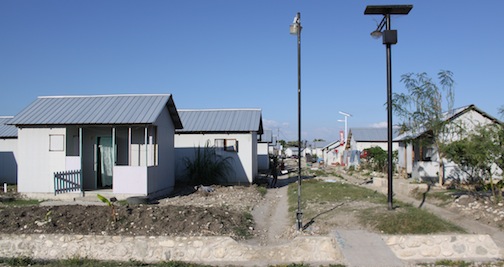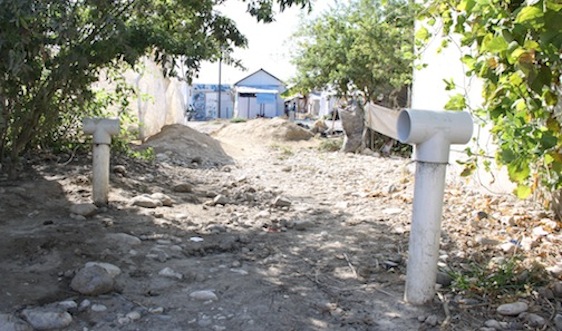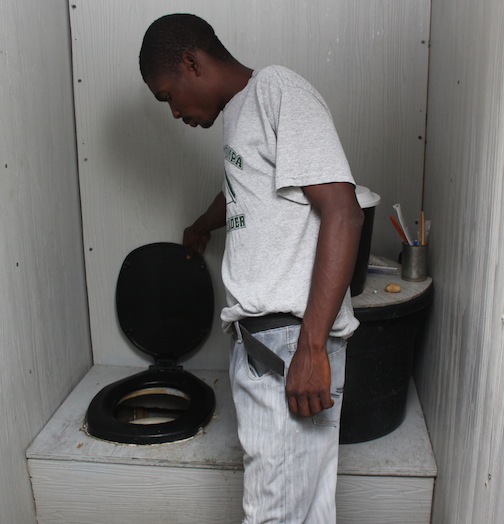Above: Septic systems dug by residents at Tabarre Issa (Photo: Fritznelson Fortune)
By Lafontaine Orvild
TABARRE, HAITI — COMPLETE WITH GALLERY AND GARDEN, 534 wood and plasterboard houses dot a gravel plot of former sugarcane fields northwest of Haiti’s capital.
At first glance, all seems normal in this metropolitan “community” called Tabarre Issa – or as normal as anything has been in a country that suffered a 7.0-magnitude earthquake 26 months ago.
In other communities set up after the quake, the displaced complain, because they are still living in tents. Here, the complaints don’t focus on the $5,000 homes, which are part of a$3 million housing investment financed by the Irish NGO Concern Worldwide.
Rather, they target the ecological toilets inside the transitional shelters. Not only have Tabarre Issa residents refused to use the toilets, but they have uprooted them.
Worse, they’ve replaced them with traditional flush toilets that empty into freshly-dug pits, which now pollute the water table.
This might be tolerable – might – if Tabarre Issa were located in a sparsely populated area. But these sewage pits share the same aquifer that fuels the capital’s water supply; dozens of trucks make the route daily.

Gerald Saintilimé and a friend dig a hole for a new toilet at the Tabarre Issa camp (Photo: Fritznelson Fortuné)
Because of Haiti’s October 2010 cholera outbreak, human excreta may be carry cholera and other pathogens. This increases the contamination risk of the country’s most important groundwater source. The health and social consequences are immeasurable.
By contrast, Concern’s toilets were specifically designed to preserve the environment. These Urinary Diversion Toilet (UDT) toilets are already being used on three continents. They separate urine from fecal matter, conserve water and produce compost.
Tabarre Issa resident Sherline Aldorange doesn’t care about the environmental impact of UDTs. She spent 2,750 gourdes ($64.11) of her own money to buy a used flush toilet, repulsed by the mere thought of having to use the free UDT she received. “No! I am not used to that sort of thing! No! This is not possible!”
Jean Auguste Petit-Frere, president of Tabbare Issa’s camp management committee, shares Aldorange’s sentiment. “These toilets spread flies, cockroaches and odors,” he fumed. “They impact health. I can no longer breathe in the cottage.”
A survey conducted in January by Haiti Grassroots Watch (HGW) of 50 families of the Tabarre Issa camp – about one-tenth of all residents – uncovered three major complaints: odor, pollutants and cockroaches. Only 2 percent of the sample pool actually used the UDT toilets and most – 90 percent said that they had since replaced them with flush toilets.
Why such distrust – revolt even – against a system which has been proven to be effective, and accepted, around the world?
Ecological toilets are a novelty in Haiti, and require a certain amount of maintenance and awareness. To use them properly, residents have to learn new ecological habits, habits they appear unwilling to make.
Concern hired Maryse François to explain to Tabarre Issa residents how to use the ecological toilets. But she herself was never able to master the system.
“I was a Concern training officer and I couldn’t adapt to this latrine. For a person who did not follow the training, it was worse!” she said. “No one who was using this system in the camp could adapt to it. It was a waste.”
Concern said it had few options, given that it was asked to supply a private privy with each house.
“Its a transitional shelter, its not a permanent residence… if you look at the options, to put in a flush toilet… the feasibility of it is not there because of the cost,” Concern’s Nick Winn said.
“If we had wanted to install the necessary water system, we would not have been able to convince a donor,” Concern assistant director Jean Frenel Thom said, adding that another $2,500 would have had to have been tacked on to each house.
The UDTs were “the safest and cleanest option that was available as far as security and hygiene,” Winn said. “Hygiene-wise, it is just completely 100 percent sound.”
“If we had wanted to install the necessary water system, we would not have been able to convince a donor.”
One hundred percent for hygiene, but zero for participation – all 50 families questioned in the survey said that Concern had failed to consult with them regarding the sanitation system.
Study after study recognizes that the idea of new toilets should be culturally accepted by the recipients first.
“The most important factors in getting a public to accept an ecological system are traditional attitudes and taboos related to defecation and excreta,” according to a 1998 study from the Swedish International Development Agency (SIDA). “If users are not implicated in the choice of an alternative ecological toilet system, cultural barriers can result in the blockage of the project.”
“These toilets were imposed,” said Diana Paul, a former Bourdon Valley resident who made a living selling charcoal before the earthquake. “They did not ask our opinion. We would have told the trainers that we didn’t want this model.”
Concern doesn’t deny the allegations, but condemns the actions taken by residents.
“They took it upon themselves to replace the systems that were installed in their homes. Is it Concern’s place to prohibit them from doing this? They’re just replacing them. We can’t do anything about it because officially, Concern doesn’t manage this camp any more,” Thom explained.
Winn is worried: “If you are putting water into a pit, it won’t take a lot to fill it up.”
One of Concern’s partner organizations, the US-based Sustainable Organic Integrated Livelihoods (SOIL), which works in ecological sanitation, was well aware of the environmental danger.
At meetings and in emails, SOIL repeatedly warned Concern about the inherent complexities of getting 534 families to accept UDTs.
“We suggested that Concern do a pilot project to receive feedback from the users before embarking on a large scale program,” SOIL director Sasha Kramer remembered. “But people were already in their homes.”
Concern contacted SOIL just three weeks before the toilets were to be completed, asking for help. The organization turned down the request, saying that an effective awareness campaign was impossible to complete in only 21 days.
Winn conceded that many camp residents don’t use the UDTs.
“They could be more successful. Definitely… the use could be better,” he said.

IN THE CUL-DE-SAC PLAIN west of the capital, the water table is very close to the surface. The state agency responsible for water and sanitation – the National Directorate Agency of Water and Sanitation (DINEPA in French) – is concerned.
“DINEPA has forbidden people to dig pits for their flush toilets,” Johanne Laroche, local liaison for the city of Tabarre, told HGW. “We recommended to all NGOs (non-governmental organizations) use the “TUFF TANK” (giant, easy to empty plastic container) in their camps to avoid contaminating the water table which is very high in that region.”
But there are no organizations working at Tabarre Issa. Concern is gone.
Tabarre City Hall and DINEPA don’t know what to do.
“We don’t have any money left, the NGOS are pulling out,” Laroche said. “We know that should prohibit people from digging pits, but where are they going to the bathroom?”
The preceding was published with the permission of the Fund for Investigative Journalism in Haiti, which made this article possible.

